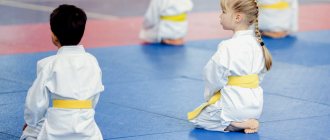- How to choose a club that is interesting for a child?
What should an ideal additional education teacher be like?
Do you want your child to study music, drawing, sports or programming with sparkling eyes? Sign him up for one of the 10 Best children's courses in St. Petersburg .
How to choose a club that is interesting for a child?
The best way to find out what classes to enroll your child in is to talk to him about this topic and find out what classes he likes and what club he would like to enroll in.
Watch your child. Take a closer look at the talent he has. Some children concentrate well in classes and quickly remember information, others can sit and draw for hours, while others require constant movement. Remember what games your child likes to play with you or with his peers.
When choosing individual or group lessons, remember that in the first, all the attention is paid to one child, so he better understands and remembers the material. In group classes, children strive to imitate each other. If all students manage to complete tasks well, then the weak child will follow others.
The price of individual lessons is 2-3 times higher than group lessons.
Don't limit your child. Offer him different activities. Let him try sports, playing an instrument, drawing, and theater.
Take him to a family master class or ask him how his first football lesson went. This way you can easily understand whether the child is interested and whether he is worth enrolling in a club or section.
At the stage of searching and determining the child’s interests, there is nothing wrong with him leaving the club after two classes.

General criteria by which you can easily choose a suitable club for your child:
- Convenience. Assess the time of visit and the area where the further education school is located. The journey should not take longer than the activity itself.
- Conditions of education. Group classes are more aimed at developing the emotional-volitional sphere, and individual classes are more aimed at logical thinking. For example, in a choir a child will learn not only to listen and sing with other children, but also to overcome the fear of public speaking. In individual singing lessons, he will better understand how to beautifully and correctly produce sounds.
- Price . This is not only the cost of the classes themselves, but also the purchase of equipment, uniforms or musical instruments.
All these criteria are covered in the catalog of the best children's courses in St. Petersburg . You can easily choose classes for your child based on location, price, curriculum and reviews.
What kinds of sports sections are there for children over 3 years old?
Sports sections for children (from 3 years old is the optimal age to start classes) have many directions and varieties. Only parents can choose the right sport, focusing on the preferences and abilities of the child.
Until the age of 3, it is important to do general strengthening gymnastics , thereby instilling in the child a love for physical activities.
About 2 years is the age at which you can discover some inclinations that will help you decide on the choice of sport.
The optimal age for starting some sports is shown in the table:
| Kind of sport | Age (for boy) | Age (for girls) |
| Basketball | 7 | 7 |
| Boxing | 8 | 8 |
| Cycling | 4 | 4 |
| Volleyball | 8 | 8 |
| Judo | 5 | 5 |
| Karate | 4 | 5 |
| Skating | 4-5 | 5 |
| Athletics | 6 | 6 |
| Swimming | 3-4 | 4 |
| Sambo | 4 | 4 |
| Gymnastics | 3-4 | 3-4 |
| Figure skating | 3 | 3 |
| Football | 4-5 | 5 |
| Hockey | 5 | 5 |
| Chess | 5 | 5 |
| Field hockey | 9 | 9 |
| Hockey with a ball | 4 | 4 |
| Gymnastics | — | 3 |
Martial arts
Types of martial arts are divided into 3 main categories:
- impact type;
- wrestling type;
- oriental martial arts.
They differ in the technology used.
The most popular destinations in Russia are:
- Boxing.
This is a high contact sport where 2 people fight wearing special gloves. There are no throws or grabs here. Kicking, head-butting or pushing is prohibited. This type is suitable for very active children with high levels of energy and endurance. Please note that the risk of injury in boxing is very high.
- Hand-to-hand combat.
This is an aggressive type of contact using punches, without the use of any weapons. Kicks are allowed. It has a high level of injuries. Suitable for very strong guys who want to learn to stand up for themselves, and for those who want to further connect their lives with military disciplines, since hand-to-hand combat is one of the mandatory army martial arts.
- Kickboxing.
Kickboxing is a type of boxing complicated by taekwondo and karate techniques. Recommendations for choosing this sport are similar to those for choosing boxing.
- Freestyle wrestling.
This is a martial arts, the essence of which comes down to using various techniques to put the opponent on his shoulder blades. Kicks are allowed. Like all contact sports, freestyle wrestling allows you to overcome your fears and learn to defend yourself.

For children with problems with the musculoskeletal system, the path to this sport is closed. In addition to the endurance that a child must have, imagination and intuition must be well developed, which will help to choose the right technique in a fight.
- Sambo.
It is a martial art that means self-defense without the use of weapons. This type of wrestling includes various techniques, the basis of which is painful - holding the enemy in a certain position that causes him pain.
Sambo is very popular among both boys and girls. Develops attentiveness and diligence. The disadvantage of this sport is the restriction on the health group: not everyone can pass the selection. Suitable for those who want to learn how to stand up for themselves, as well as to improve their physical fitness.
- Judo.
This is a martial art whose homeland is considered to be Japan. Combines a wide variety of throws, painful and choking techniques. It differs from other martial arts in that less physical force needs to be used here, giving preference to the technique of movements.
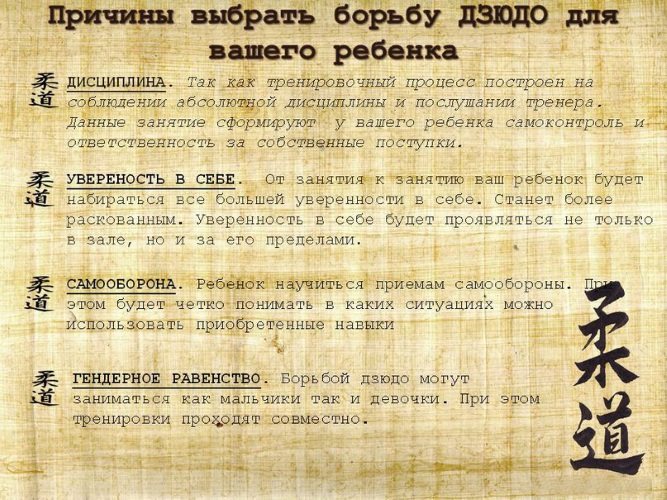
Judo develops endurance, masculinity and will. The downside is the risk of injury due to the large number of throws. This look is suitable for shy guys who find it difficult to express themselves. Also for those who want to develop body flexibility and plasticity.
- Karate.
Karate is one of the most famous types of wrestling. Characterized by the absence of prolonged contact between opponents. The basic principle is to deliver a striking point blow with a hand or foot to the enemy’s vulnerable spot. This type develops attentiveness, reaction speed and clarity of movements.
The downside may be a large list of medical contraindications. Slow and absent-minded children who are prone to forget and lose everything should be enrolled in this sport. Very emotional children with increased excitability will also benefit: karate will help them become calmer and more balanced.
- Greco-Roman wrestling.
This is a European type of martial arts based on the use of a number of throws and various techniques in order to unbalance the opponent. Develops attentiveness, precise coordination of movements and willpower.
This sport is suitable for shy and timid guys who want to overcome their inhibitions. The downside, like other types of wrestling, is a lot of contraindications (cardiovascular diseases, autoimmune disorders).
- Aikido.
This is another Japanese type of wrestling. Many people recognize Aikido as the most spectacular form of martial arts. The movements of the opponents here are graceful and dynamic. Aikido can use various weapons.
In addition to physical development, spiritual integrity comes to the fore here. There is a whole philosophy behind this sport. This sport is suitable for self-confident and persistent children, as well as for those who need to develop coordination of movements and the ability to concentrate. This is a good option for girls.
- Taekwondo.
Taekwondo is a tough martial arts sport characterized by aggressive kicking and punching techniques. Develops courage and endurance. However, it is characterized by a high degree of injury. Suitable for strong and strong-willed guys who can withstand aggression.
Team sports
Sports sections for children from 3 years old, based on team sports, are increasingly gaining popularity . An important feature here is not only the emphasis on the child’s physical fitness, but also his ability to be part of the whole and the ability to interact with other team members.
The most popular types:
- Football.
This is a well-known team game between two groups, the essence of which comes down to scoring the ball into the opponents’ goal. The sport aims to develop endurance, speed and the ability to interact. Perfect for small children who can withstand physical activity for a long time. The downside is the high risk of injuries, sprains, and bruises as a result of inevitable falls.
- Basketball.
This is a sport in which you need to throw a ball into the opposing team's basket. Develops analytical abilities of the mind, coordination of movements and strong-willed qualities. The main disadvantage is that prospects, as a rule, await only tall children. This type is suitable for brave and speedy children who have dexterity and the ability to quickly find a way out of a situation.
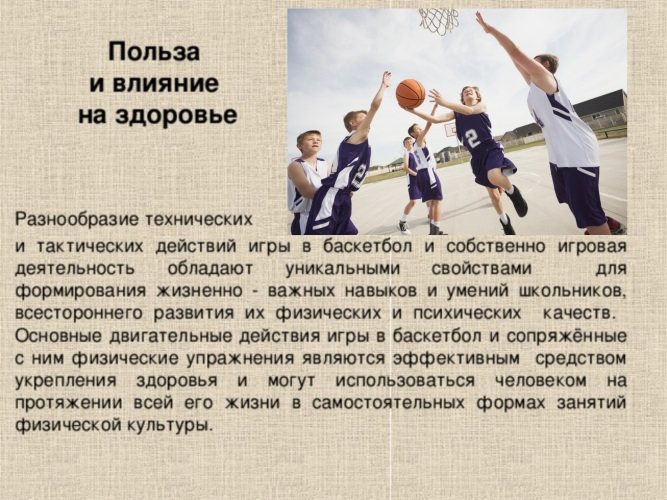
- Volleyball.
This is an active sport that involves working with the ball between players of 2 teams. A characteristic feature is a mesh stretched between the fields. Volleyball is considered a game for older children, but from the age of 3, parents can begin to prepare their child for it. Exercises develop joint mobility and have a beneficial effect on the child’s respiratory system.
The downside may be the high level of trauma to the cervical vertebrae during play and restrictions on the child’s height: the success of tall children in the game prevails. This sport is suitable for those who need to develop attentiveness and improve posture.
- Hockey.
This is the most fashionable sport among children and teenagers. A team sport where players on an ice rink try to hit the puck into the opponents' goal with a stick. They move exclusively on skates. Hockey is suitable for dexterous and energetic children; good coordination of movements and quick decision-making are also very important.
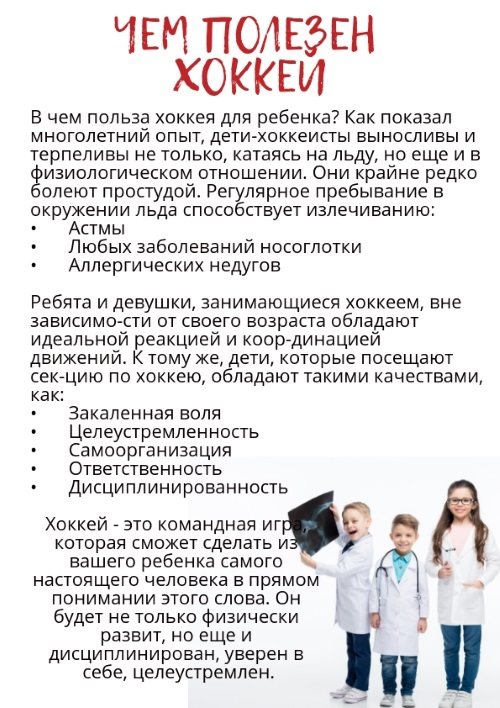
The main disadvantage is the high costs required to purchase equipment. The risk of injury is also very high here.
Gymnastics
Sports sections for children from 3 years old amaze with their diversity. However, doctors advise starting your acquaintance with sports with gymnastics.
Gymnastics is a generalized concept that unites various areas:
- gymnastics;
- health-improving gymnastics.
Health-improving gymnastics includes physical exercises, exercises and gentle stretching. It is aimed at general health improvement and physiological development. Therefore, this is the same type where it is recommended to send a child over 3 years old. There are no heavy loads here, and no special training is needed.
There are no disadvantages. On the contrary, it is desirable that any sport begins with recreational gymnastics.
Artistic gymnastics is based on recreational gymnastics, complicated by a higher level of physical activity. This section is not recommended for children over 3 years old. It is advisable to wait and let the body get stronger for such serious loads.
These include:
- rhythmic gymnastics;
- trampolining;
- athletics and weightlifting.
Gymnastics has a positive effect on plasticity, flexibility, and joint mobility. Recommended for active and restless children.
Contraindications: spinal diseases and cardiovascular disorders.
Swimming
One of the most beneficial sports for children is swimming. Its beneficial effects on the body have been known for a long time.
Here are just a few of them:
- strengthening the immune system;
- positive effect of distributed load on all muscle groups during training;
- improved coordination of movements;
- proper development of the respiratory system;
- positive emotional impact.
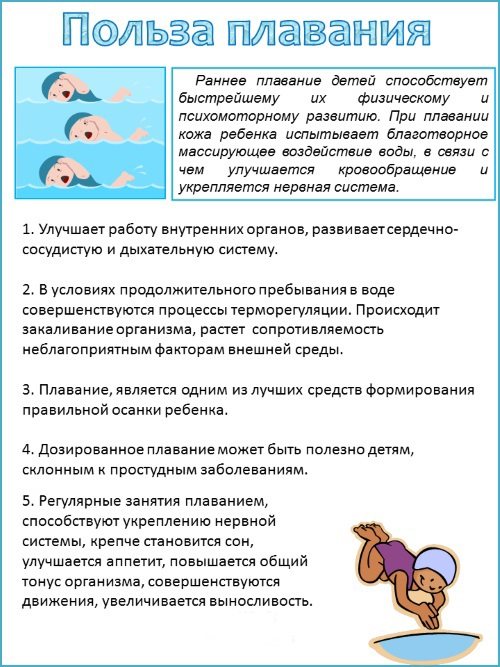
The main disadvantage of this sport is the presence of a dangerous and harmful component in pools - chlorine. Scientists have proven that frequent visits to places with chlorinated water can sooner or later lead to lung diseases (asthma).
Also, this toxic element negatively affects the condition of the skin, hair, nails and the entire body as a whole. Therefore, for swimming, it is recommended to choose pools with innovative water purification systems, which have become so popular recently.
Choreography
Choreography is a sport that combines both the physical and cultural development of a child. By doing this, the child develops an ear for music and works on the flexibility of his own body. Classes feature well-balanced sets of exercises that have a very beneficial effect on a growing body.
Children's posture becomes much better and stronger. For children aged 3 years and older, this section is an excellent and gentle way to start getting acquainted with dancing, which can later lead to professional training.
The main advantage of choreography classes is the absence of contraindications. Therefore, it is suitable for absolutely any child.
What should an ideal additional education teacher be like?
The choice of the teacher determines whether the child wants to attend the club and develop in the chosen direction.

Talk to the teacher in person. Come to a trial lesson with your child and observe the atmosphere in the lesson.
The teacher must be active and good-natured, and be able to win over every student. He is responsible not only for the skills that the child will receive, but also for the atmosphere in the children's team. If you see that the teacher is sensitive by nature, knows how to stop children’s conflicts and meets the child halfway if something doesn’t work out for him, then you are lucky. You have found a teacher with a capital T!
Find out about the teacher's education , it must correspond to the profile of the classes.

WHERE TO SEND YOUR CHILD TO WORK
The doors of the European Gymnastics Center are always open for young athletes in Moscow and the Moscow region, on the basis of which there are sports sections for children from 4 years old. With your convenience in mind, we do not insist that children come to classes from the beginning of the school year. You can enroll your child at any time, including the summer season, holidays and weekends. Even if your baby came to the section later than other group members, he will not lag behind. The coach always pays attention to working on the material already covered, thanks to which the rookie athlete will soon be able to easily master the current training program and will learn new elements and exercises on an equal basis with everyone else. At the same time, parents do not have to worry about his safety. In well-equipped rooms and in the presence of mentors, children feel as comfortable and protected as possible.
How to choose the right children's sports section?
Sports sections are necessary for everyone. By sending your child to play sports at an early age, you will help him have a good figure and physical fitness in the future. Sports sections are most relevant for very active children who need to throw out their energy.
Every sport has health contraindications.
Sports schools provide spacious, clean training rooms and the necessary sports equipment. Parents buy individual uniforms and comfortable shoes.

It is absolutely forbidden to force a child to go to classes if he does not want to. Forget about your ambitions that you dreamed of raising a famous figure skater or football player. What matters is what your child wants. Don't blackmail him by promising that if he doesn't study, you won't talk to him or won't buy him a toy.
If your child cries after class, talk to him. Find out what he doesn't like or what he's afraid of. It may be painful for him to do some exercises. Explain that this will not always be the case, soon he will learn to do everything with ease and without pain. If a child responds to your questions with impenetrable partisan silence, talk to the teacher, maybe he will explain the reason for the tears.
If your child has been returning from classes in tears for a month, put them off for a while so that the refusal to learn does not spread to all areas. Go to a child psychologist to understand the reason for this behavior.
How to manage everything?
This is the most important question for parents who object to after-school activities. And the most common mistake.
In fact, a busy daily routine disciplines a child, organizes him better than any punishment or instruction, teaches him to manage time and value it. It’s just that life itself forces a student to do everything - this is the only condition not to get bad grades in classes and to complete work in clubs.
Another thing is that mothers (and fathers too) should initially help the child organize his daily routine. You can even schedule it minute by minute: when is lunch, when are lessons, and when do you have to go to class.
But you won’t have a headache trying to pull your child away from the TV, and you won’t be tormented by the question of where he goes in the evenings. The child is busy!
How to choose a vocal studio or music school?
If a child hums songs all day long, is interested in dad's guitar, or sings along to music videos, then he is definitely interested in music.
It is possible to understand whether a child has hearing and musical abilities only through practical classes. Send your child to study at a public school or private studio.
The advantage of state music schools is free education. But they do not have a personal approach to the child, there is only an established program, assessments and exams.
Private studios are aimed at maintaining a child’s interest in music. The teacher develops an individual lesson plan based on the student’s abilities.
There are courses in music lessons in small groups. They are divided according to the age and initial skills of the students to create a general training program.
At the state music school, students study from 6 to 8 years. If it is not yet clear to you how interested your child is in music, sign him up for short courses. Then, together with the teacher and the child, decide how to further develop in the musical direction.
Deciding between singing and playing an instrument? Listen to your child, he will tell you what is more interesting to him. For the purity of the experiment, enroll your child in both classes and let him determine the appropriate direction.
How much does it cost?
- Swimming - from 3.5 thousand rubles. per month
- Basketball - from 2 thousand rubles. per month
- Figure skating - from 4.5 thousand rubles. per month
- Alpine skiing - from 6.5 thousand rubles. per month
- Aikido - from 3 thousand rubles. per month
- Singing - from 1 thousand rubles. per month
- Fencing - from 3 thousand rubles. per month
- Archery - from 1.5 thousand rubles. month
- Classical dances - from 2 thousand rubles. per month
- Theater club - from 2 thousand rubles. per month
- Horse riding - from 6 thousand rubles. per lesson
How to choose a theater group?
If your child loves to perform in front of family, sing and dance, then theater courses will help reveal his talents. If a child is shy, then creative activities will give him self-confidence.
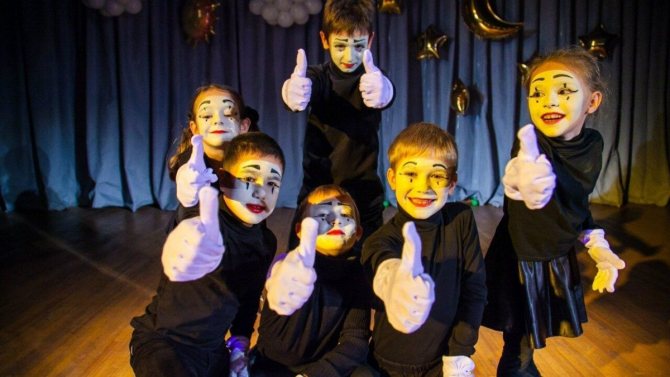
Acting classes teach children to adapt in society, relieve tension and improve speech. By studying in such a circle, you can quickly understand whether a child has leadership qualities.
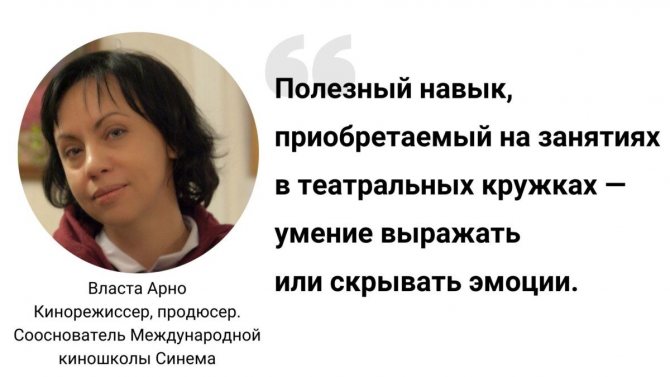
You can take your child to film courses or a theater club from the age of 3-5. This will eliminate difficulties in communication, learn to express yourself and make friends with peers.
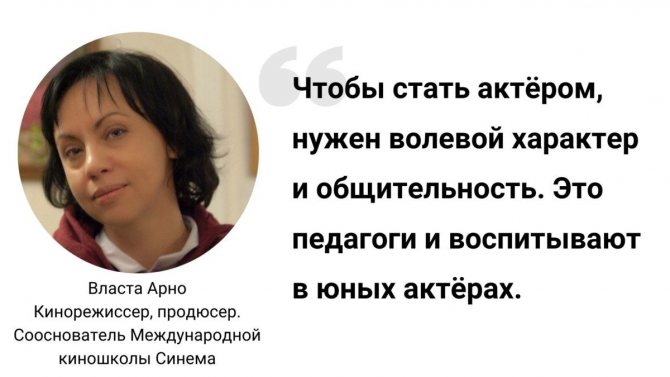
The theater course curriculum includes:
BENEFITS OF CHILDREN'S SPORTS
Playing sports from the age of 4 sets the right direction for the development of a child’s body - they comprehensively train all muscle groups, help develop coordination and balance, flexibility, grace and endurance. That is, in the process of training, boys and girls acquire all those qualities that prepare them for adult training. According to doctors, regular training also strengthens children's immunity, thanks to which athletes are much less likely to catch colds and get sick than their untrained peers. During classes in the section, children have the opportunity to run, climb and have fun to their heart’s content - that is, not only get a lot of positive energy, but also find a useful application for their irrepressible and overflowing energy. After such active activities in the section, it is much easier to involve the child in intellectual work or creative work that requires patience.







